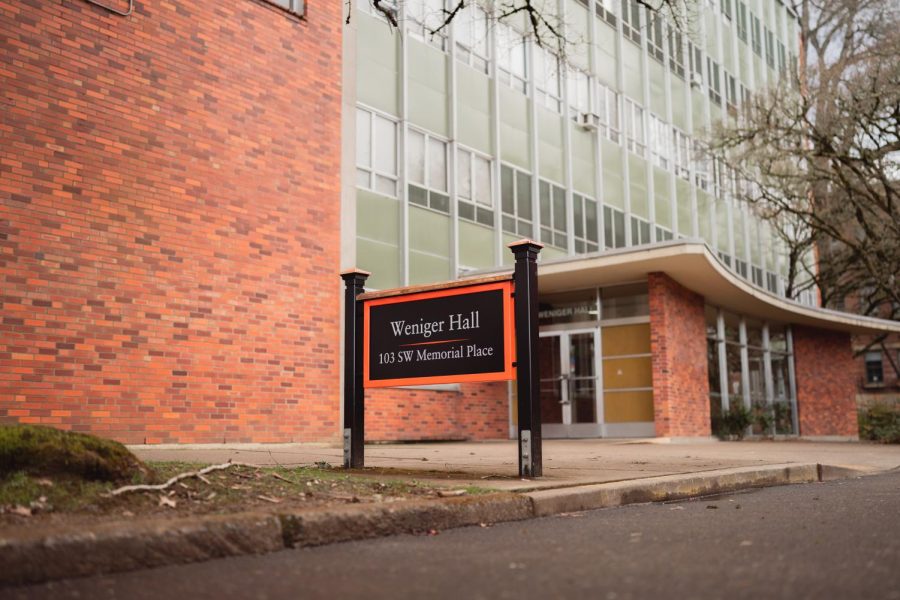Weniger Hall tenants prepare for demolition
April 4, 2023
In the fall of 1962, the Cuban Missile Crisis was at its peak, China and India were at war, and, according to that day’s Daily Barometer, Oregon State University was dedicating its newest building on Oct. 26.
The dedication ceremony for what was then the Physics-Chemistry Building took place over two days, Oct. 26 and 27, and featured speeches from a pair of Nobel Prize winners: Chemist Willard Libby and Physicist Edwin McMillan.
The building, construction of which cost the university $5 million, has since been renamed Weniger Hall in honor of physicist and former graduate school dean Willibald Weniger.
However, the building’s days are numbered, as OSU is planning for Weniger Hall’s demolition.
According to OSU’s 10-year financial forecast, available on OSU’s university facilities, infrastructure and operations website, the building will be torn down to make room for the construction of the university’s $166 million Collaborative Innovation Complex. According to the report, removing the aging building also eliminates $70 million in deferred maintenance costs.
According to Erin Martin of OSU’s Department of Finance and Administration, tearing down the building is expected to take anywhere from a year to 16 months, and will necessitate closing surrounding streets and sidewalks.
The demolition is currently scheduled to take place between now and 2025, although according to Martin, the university doesn’t currently have a firm timeline.
In addition to the CIC’s construction, and Weniger Hall’s destruction, OSU will also be renovating Plageman Hall, currently home to student health services, and the currently vacant Heat Plant Building, according to the financial forecast, with both projects providing new accommodations for Weniger Hall’s current tenants.
“The college of science has been planning for the relocation of the college’s faculty and staff in Weniger for a few years now,” said Lisa Ganio, department head for OSU’s Department of Statistics, which will be moving into Plageman Hall.
Ganio added that while the department’s offices may be moving, the move will have no impact on the department’s ability to teach.
“(Statistics classes) are assigned to classrooms all over campus, so relocating our offices won’t impact where we teach our classes,” Ganio said.
Meanwhile, the physics department will be moving into the Heat Plant Building, according to Davide Lazzati, department head at OSU. Given the nature of the department’s research, Lazzati expects a more challenging move away from Weniger Hall.
“Relocating a highly experimental program is going to be disruptive,” Lazzati said. “Heavy and delicate equipment will need to be prepped for moving, physically moved and then set up in the new building. This is certainly going to take some time and cause a delay in research accomplishments.”
According to Lazzati, these delays may impact graduate student research and could have an impact on their graduation.
“As a community, we will strategize and set procedures in place to ensure that students are minimally affected by the relocation,” Lazzati said.
According to Lazzati, the effects the move will have on physics department faculty remain to be seen since availability of suitable research space and classrooms in the Heat Plant Building won’t be known until after its renovation is completed.
“Most of the effect on faculty really depends on how the new building will shape up,” Lazzati said. “We are working with the architects to ensure that the change is going to be beneficial in all aspects.”


















































































![Newspaper clipping from February 25, 1970 in the Daily Barometer showing an article written by Bob Allen, past Barometer Editor. This article was written to spotlight both the student body’s lack of participation with student government at the time in conjunction with their class representatives response. [It’s important to note ASOSU was not structured identically to today’s standards, likely having a president on behalf of each class work together as one entity as opposed to one president representing all classes.]](https://dailybaro.orangemedianetwork.com/wp-content/uploads/2025/03/Screenshot-2025-03-12-1.00.42-PM-e1741811160853.png)

























